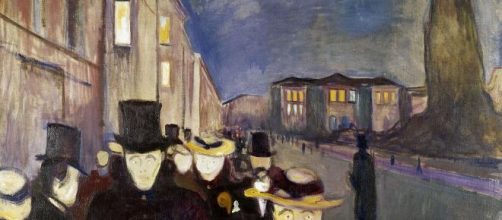I think we can all agree that there’s enough predicament and plight in the world without sensationalizing it with blood-and-thunder exaggerations.
So, it’s hard to understand why an Edvard Munch show at the Courtauld Gallery in London gets headlined in a leading British newspaper with nothing more than sneaking suspicions written as fact.
Like this: “Zombie workers and sexual hang-ups: how Edvard Munch foresaw our lonely lives.”
Yes, several of Munch’s paintings are about unhealthy things, including sickness and death – leftover traumas from childhood – but I don’t see them as predictors of anyone’s loneliness, as The Guardian claims.
The Guardian headline also wrongly suggests that "zombie workers and sexual hang-ups" are all there is to the Munch’s show. You’d never know from its screamer that the show includes paintings like “Summer Night: Inger on the Beach,” a portrait of Munch’s youngest sister Inger seated at the seashore off the coast of Oslo fjord in 1889.
Inger rests dreamily on a rock holding a straw hat as if to take in some sun. Her white dress appears all the more distinct next to the blues of the ocean and the grays of the granite.
Munch’s doting image wasn’t some one-time moment of sentiment that never showed in his work again. He pictured the same pose five years earlier, this time showing Inger at age 14, and in a black confirmation dress seated at the edge of her bed.
He called it “Morning.”
There’s not a speck of angst in either work; although Munch said in a statement that he saw the seaside rocks as living beings, like goblins. In a stretch, they could be viewed as demons. If so, our times don’t have a lock on those.
Despite the benign nature of Inger’s portrait, Reviewers in Norway hated it. (I don’t like it, either. More about that in a moment). The Morgenbladet panned it as “gibberish.” The Aftenposten saw it as “a physical entity with no trace of life and expression, and as untrue in the form as in the color.” Wait, there’s more.
Low blow
Aftenposten said that “on the whole, this seems to us to have such a low artistic value that his presence at the exhibition itself is difficult to defend.”
As I say, I have a problem with this painting, too, but I’d never call it “shapeless.” Just the opposite.
Those rocks are more like boulders and rendered so boldly that they detract from the subject.
Mercifully, one publication – Dagbladet – appeared to defend the paintings saying: "To understand it, one must constantly have in mind that Munch is a person who can be entirely covered by a mood without regard to conventional laws and forms, often with a tendency to fantasy."
Look back in anger
The bad reviews have me wondering now if they drove Munch away from quiet pictures like those of his sister headlong into painting his childhood traumas. Those hang-ups certainly have The Guardian singing their praises.
England’s leading art critic Jonathan Jones is particularly taken with a painting Munch called “Woman in Three Stages” (from young to old) painted only six years after completing Inger's portrait.
Jones wrote that “Women in Three Stages” “looks like a big bloodstain: he has hurled red paint at the canvas to create this gash of horror. Or at least that’s what I’m assuming happened. Perhaps they should test to see if it’s blood.” Really, Jonathan?


